Optical Telescopes
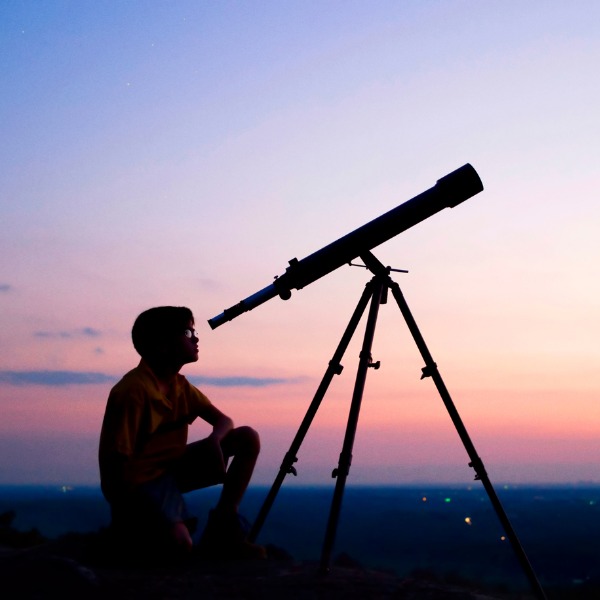
Boy looking through telescope at night (stevecoleimages, iStockphoto)

Boy looking through telescope at night (stevecoleimages, iStockphoto)
How does this align with my curriculum?
Learn about the history of telescopes and the function of refracting and reflecting optical telescopes.
Astronomy
Astronomy comes from the Greek words “astron” meaning ‘star’ and “nomos” meaning ‘law.’ It is the study of everything that exists beyond the Earth. But it is really about the study of light. Whether you are doing research, or just gazing up at the night sky, everything that you see is in the form of light. On a clear dark night, there can be lots to see!
Long ago, astronomers could only see what was beyond Earth using their eyes. But the human eye is not good at seeing details of dim and distant objects. There is much we cannot see with our eyes alone.
The Telescope
To help see objects in space, a device called a telescope was invented. A telescope is a tool that makes far off things look up-close and bright.
The invention of the first telescope is a little sketchy. Most people believe that Galileo Galilei invented the first telescope in 1609. But people knew how to build telescopes before that. We just do not have any evidence before Galileo. The earliest telescopes we know of were made in 1608 by people who shaped glass in the Netherlands.
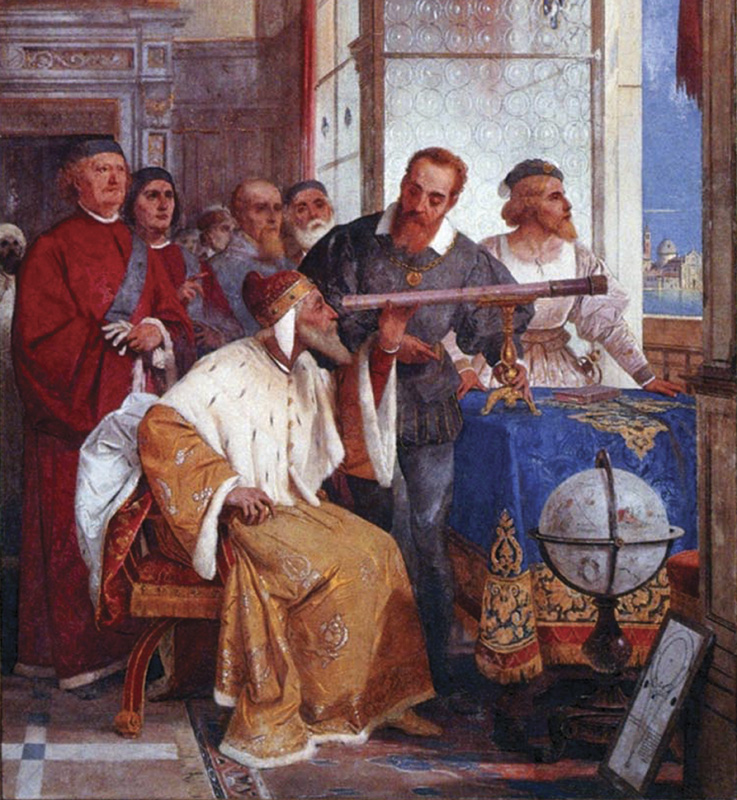
Image - Text Version
Shown is a painting of a person looking though a telescope while another person talks to them.
The main focus of the image is a person with a pointed grey beard. They are wearing long, gold robes trimmed with white fur, and sitting on a chair at the front of the room.
This person is looking through one end of a long, tubular object. It is sitting on an intricate gold stand, on a table in front of the chair. This object is pointed out the open window on the right side of the painting.
A person is standing just behind the chair. They have a red beard and are wearing a dark suit. They are looking down and speaking to the person looking through the telescope.
In the background, five or six more people in red and grey robes are standing, looking out the same window.
A New View of the Moon (2018) by To Scale (3:18 min.)
In 1923, Edwin Hubble used the most powerful telescope on Earth to look at the Andromeda Galaxy. He used it to measure how far away the galaxy is from Earth.
Did you know?
The Hubble Space telescope is named after astronomer Edwin Hubble.
Since astronomers already knew the approximate size of the Milky Way galaxy, Hubble could use that data to calculate the distance to the Andromeda Galaxy. He determined that the Andromeda Galaxy was at least ten times further away than the edge of the Milky Way. This discovery helped astronomers find other galaxies. It also helped to expand our ideas about the Universe.
How Do Telescopes Work?
So how exactly do telescopes work? Let's consider a basic telescope. If you were looking to buy a telescope, you would learn that there are two basic designs. There are refracting telescopes, also known as refractors, and reflecting telescopes, also known as reflectors.
Refracting Telescopes
Refracting telescopes are the long, tube-shaped telescopes which you might imagine Galileo using. Refractors use lenses to refract incoming light through a tube to a focal point. Refractors typically have two lenses. The objective lens is the lens at the front of the telescope. This is the lens which light passes through. The eyepiece is the lens that magnifies the image.
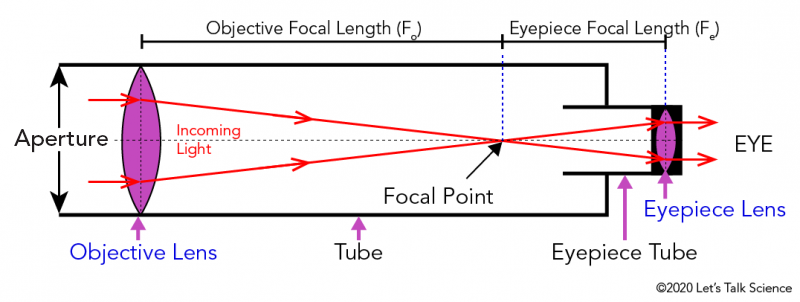
Image - Text Version
Shown is a colour diagram of how light travels through a refracting telescope.
The diagram is a long rectangle, labelled "Tube." It is open on the left end, and this is labelled "Aperture." Just inside the aperture is a purple shape with two sides that curve outwards. This is labelled "Objective Lens."
On the right end of the tube is a smaller tube, labelled "Eyepiece Tube." On the right end of this is another purple shape with two sides that curve outwards. This is labelled "Eyepiece Lens." The space to the right of this is labelled "Eye."
Two long red arrows are labelled "Incoming Light." They are horizontal and parallel as the travel through the aperture. Then they bend toward each other. The two arrows cross about three quarters of the way down the tube. This point is labelled "Focal Point." After the arrows cross, they travel away from each other, through the tube. When they hit the eyepiece lens, they become parallel again.
Above the tube, the distance between the objective lens and the focal point is labelled "Objective Focal Length (Fo)." The distance between the focal point and the eyepiece lens is labelled "Eyepiece Focal Length (Fe)."
Reflecting Telescopes
Reflecting telescopes use mirrors instead of lenses to reflect light to a focal point. Reflectors have two mirrors. The primary mirror is the big curved mirror at the back of the tube that begins to focus the light. The secondary mirror is the smaller mirror at the front of the tube. It redirects the light towards your eye. Reflectors also have eyepiece lenses.
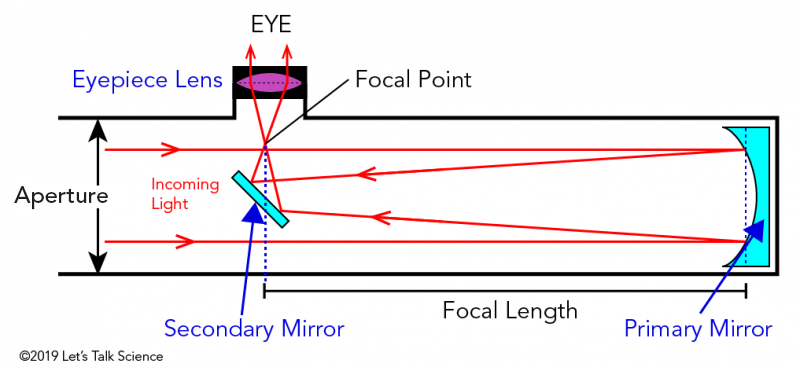
Image - Text Version
Shown is a colour diagram of how light travels through a reflecting telescope.
The diagram is a long rectangle. It is open on the left end, and this is labelled "Aperture." Just inside the aperture is a purple shape with two sides that curve outwards. This is labelled "Objective Lens."
At the right end of the tube is a blue shape. Its right side is flat, but its left side curves inward. This is labelled "Primary Mirror."
A thin blue rectangle sits diagonally across the tube about one quarter of the way down its length. This is labelled "Secondary Mirror." It is angled up towards a small opening at the top of the tube. There is a purple shape across the opening, with two sides curved outward. This is labelled "Eyepiece Lens." The space above this lens is labelled "EYE."
Two long red arrows are labelled "Incoming Light." They are horizontal and parallel as the travel through the aperture and along the tube. When they hit the primary mirror at the end, they reflect back down the tube and toward each other.
When the arrows hit the secondary mirror, they reflect up towards the eyepiece mirror. The arrows cross over each other about halfway to between the secondary mirror and the eyepiece lens. This is labelled "Focal Point."
When the arrows pass through the eyepiece lens, they bend to become parallel again, but vertical.
Below the tube, the distance between the focal point and the primary mirror is labelled "Focal Length."
Which type of telescope is better?
It's not really fair to say which type of telescope is 'better’. They both have their advantages and disadvantages. It depends on what you want to look at. It also depends on whether you want to use it to take pictures, or move it from place to place.
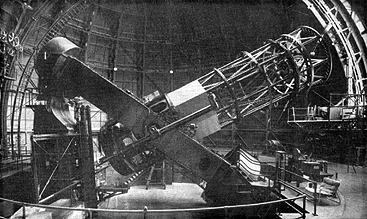
Image - Text Version
Shown is a black and white photograph of a dome-shaped room with a tubular structure inside.
A wide beam cuts diagonally across the bottom left corner of the image. Fastened to its centre is a long, spherical structure made from metal beams. This is angled toward the top right corner of the image, where a sliver of black sky is visible outside the domed roof.
Aperture
There are two other important aspects of telescopes. These are the aperture and focal length. The aperture of the telescope is the diameter of the opening on the front. The bigger the aperture the more light that can enter the telescope.
Did you know?
The pupil in your eye is also an aperture. Unlike a telescope, it can only open a few millimetres.

Image - Text Version
Shown is a colour photograph of a large white structure with a domed roof, at the top of a hill.
The structure is bright white against deep blue sky. The moon is rising faintly over the horizon in the background. The structure has a cylindrical base and a spherical top. Two seams cross over the top of the dome, as if this part might open.
The land below is dark brown, barren, and dusted with white snow.
Focal Length
Focal length is the length from the aperture to the focal point in the telescope. Longer focal lengths allow for greater magnification. However, the longer the focal length, the smaller the patch of sky you can see. Long focal length also means long tubes - at least for refractors. This is where reflectors have an edge. Since reflectors use mirrors to reflect light, they can be shorter than their focal length. The light still travels the full focal length, but the tube itself does not need to be as long. The eyepiece near the focal point magnifies the image.
You might be thinking that every telescope should have the biggest aperture and longest focal length possible. Aside from things such as cost and storage space, there are other reasons why this is not a good idea.
First, for anyone who studies our solar system, aperture really is not that important. Most of the planets are visible using small telescopes. Objects like the Moon are so bright that having an aperture that is too big can make the image too bright!
Secondly, even small telescopes, such as ones with apertures of 20 cm, are able to let us see hundreds of galaxies and nebulae. Some of these can be up to a hundred million light-years away!
Did you know?
Galaxies are large systems of stars, gases and dust. Nebulae are interstellar clouds of dust and hydrogen gas.
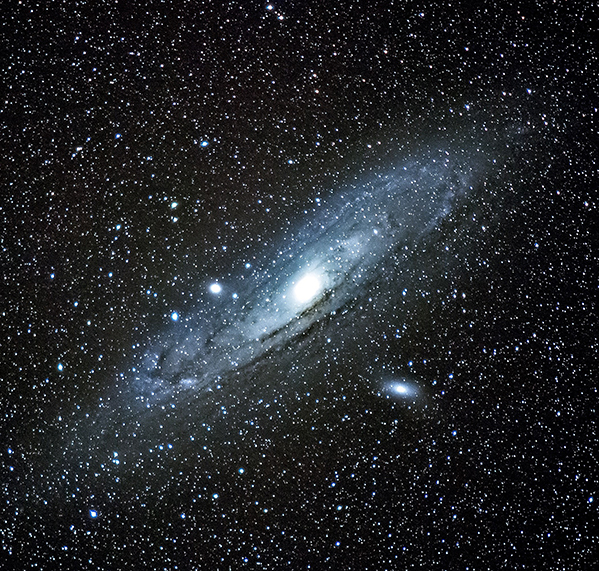
Image - Text Version
Shown is a colour photograph of a wispy, elliptical formation around a large, bright white star. Several more bright stars are scattered nearby. Everything is set against black space dense with tiny white stars.
Learn More
Building the 100-inch Telescope
Learn how the 100-inch Hooker telescope at the Mount Wilson Observatory was built. The page includes several videos.
Telescopes: Crash Course Astronomy #6 (2015)
Crash Course explains how telescopes work and offers up some advice for buying a telescope
References
Greene, N. (2019, July 3). Hans Lippershey: Telescope and microscope inventor. ThoughtCo.
Owens, S. (n.d.). Reflecting vs. refracting stargazing telescopes. Dummies.
Smith, R. (n.d.). Edwin Hubble. Encyclopaedia Britannica.
University of Oregon. (n.d.). Reflecting telescope.
Van Alden, A. (n.d.). Galileo. Encyclopaedia Britannica.